Food Safety Management and Regulations
VerifiedAdded on 2020/10/22
|11
|3692
|96
AI Summary
The assignment discusses various ways through which food gets polluted and how managers eliminate these risks to process better-quality food products. It also mentions different legislations formulated by governments to ensure customers get better quality food products. The document references several books and journals that provide insights into traceability in the food supply chain, implementation of non-regulatory food safety management schemes, emerging risk management metrics, and factors affecting the status of food safety management systems.
Contribute Materials
Your contribution can guide someone’s learning journey. Share your
documents today.
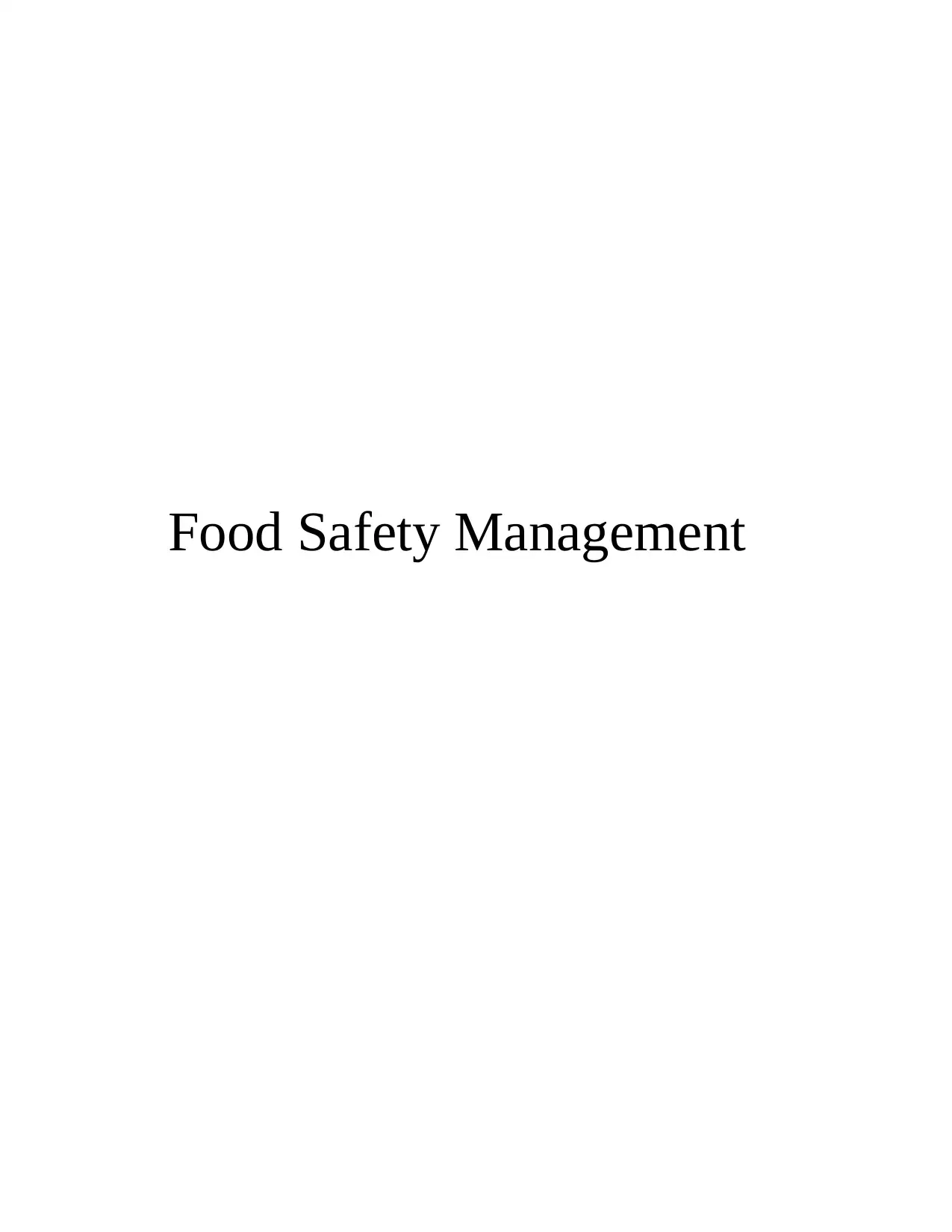
Food Safety Management
Secure Best Marks with AI Grader
Need help grading? Try our AI Grader for instant feedback on your assignments.
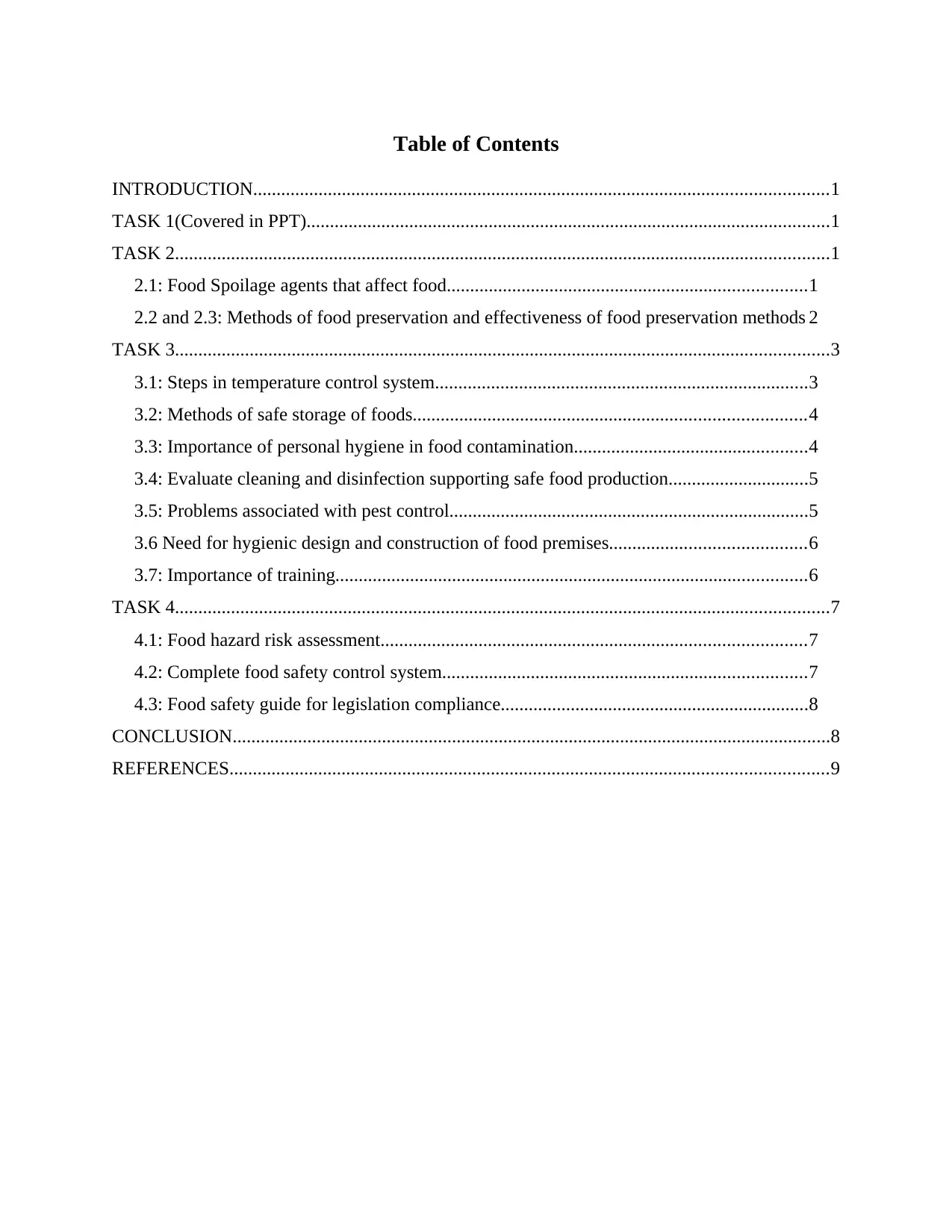
Table of Contents
INTRODUCTION...........................................................................................................................1
TASK 1(Covered in PPT)................................................................................................................1
TASK 2............................................................................................................................................1
2.1: Food Spoilage agents that affect food.............................................................................1
2.2 and 2.3: Methods of food preservation and effectiveness of food preservation methods 2
TASK 3............................................................................................................................................3
3.1: Steps in temperature control system................................................................................3
3.2: Methods of safe storage of foods....................................................................................4
3.3: Importance of personal hygiene in food contamination..................................................4
3.4: Evaluate cleaning and disinfection supporting safe food production..............................5
3.5: Problems associated with pest control.............................................................................5
3.6 Need for hygienic design and construction of food premises..........................................6
3.7: Importance of training.....................................................................................................6
TASK 4............................................................................................................................................7
4.1: Food hazard risk assessment...........................................................................................7
4.2: Complete food safety control system..............................................................................7
4.3: Food safety guide for legislation compliance..................................................................8
CONCLUSION................................................................................................................................8
REFERENCES................................................................................................................................9
INTRODUCTION...........................................................................................................................1
TASK 1(Covered in PPT)................................................................................................................1
TASK 2............................................................................................................................................1
2.1: Food Spoilage agents that affect food.............................................................................1
2.2 and 2.3: Methods of food preservation and effectiveness of food preservation methods 2
TASK 3............................................................................................................................................3
3.1: Steps in temperature control system................................................................................3
3.2: Methods of safe storage of foods....................................................................................4
3.3: Importance of personal hygiene in food contamination..................................................4
3.4: Evaluate cleaning and disinfection supporting safe food production..............................5
3.5: Problems associated with pest control.............................................................................5
3.6 Need for hygienic design and construction of food premises..........................................6
3.7: Importance of training.....................................................................................................6
TASK 4............................................................................................................................................7
4.1: Food hazard risk assessment...........................................................................................7
4.2: Complete food safety control system..............................................................................7
4.3: Food safety guide for legislation compliance..................................................................8
CONCLUSION................................................................................................................................8
REFERENCES................................................................................................................................9
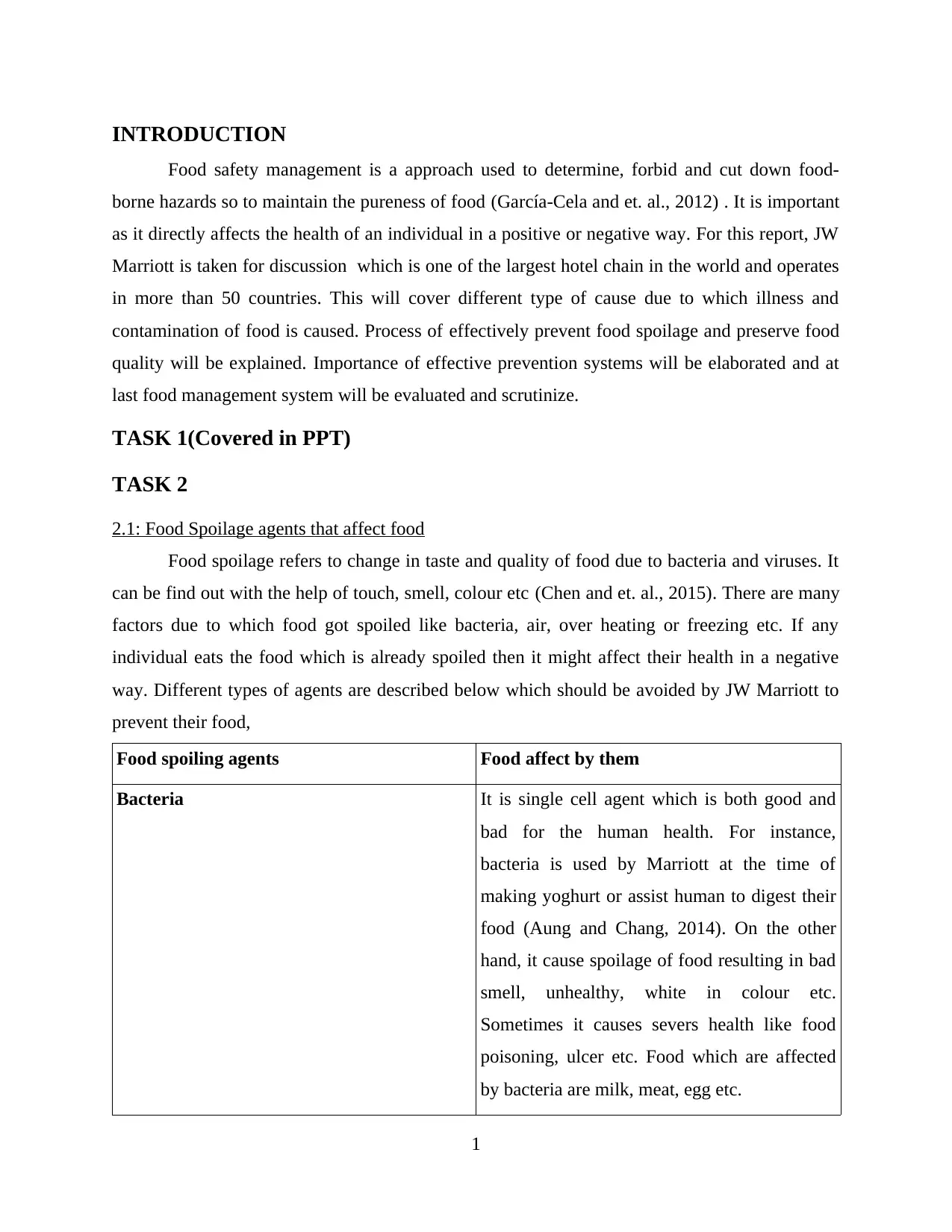
INTRODUCTION
Food safety management is a approach used to determine, forbid and cut down food-
borne hazards so to maintain the pureness of food (García-Cela and et. al., 2012) . It is important
as it directly affects the health of an individual in a positive or negative way. For this report, JW
Marriott is taken for discussion which is one of the largest hotel chain in the world and operates
in more than 50 countries. This will cover different type of cause due to which illness and
contamination of food is caused. Process of effectively prevent food spoilage and preserve food
quality will be explained. Importance of effective prevention systems will be elaborated and at
last food management system will be evaluated and scrutinize.
TASK 1(Covered in PPT)
TASK 2
2.1: Food Spoilage agents that affect food
Food spoilage refers to change in taste and quality of food due to bacteria and viruses. It
can be find out with the help of touch, smell, colour etc (Chen and et. al., 2015). There are many
factors due to which food got spoiled like bacteria, air, over heating or freezing etc. If any
individual eats the food which is already spoiled then it might affect their health in a negative
way. Different types of agents are described below which should be avoided by JW Marriott to
prevent their food,
Food spoiling agents Food affect by them
Bacteria It is single cell agent which is both good and
bad for the human health. For instance,
bacteria is used by Marriott at the time of
making yoghurt or assist human to digest their
food (Aung and Chang, 2014). On the other
hand, it cause spoilage of food resulting in bad
smell, unhealthy, white in colour etc.
Sometimes it causes severs health like food
poisoning, ulcer etc. Food which are affected
by bacteria are milk, meat, egg etc.
1
Food safety management is a approach used to determine, forbid and cut down food-
borne hazards so to maintain the pureness of food (García-Cela and et. al., 2012) . It is important
as it directly affects the health of an individual in a positive or negative way. For this report, JW
Marriott is taken for discussion which is one of the largest hotel chain in the world and operates
in more than 50 countries. This will cover different type of cause due to which illness and
contamination of food is caused. Process of effectively prevent food spoilage and preserve food
quality will be explained. Importance of effective prevention systems will be elaborated and at
last food management system will be evaluated and scrutinize.
TASK 1(Covered in PPT)
TASK 2
2.1: Food Spoilage agents that affect food
Food spoilage refers to change in taste and quality of food due to bacteria and viruses. It
can be find out with the help of touch, smell, colour etc (Chen and et. al., 2015). There are many
factors due to which food got spoiled like bacteria, air, over heating or freezing etc. If any
individual eats the food which is already spoiled then it might affect their health in a negative
way. Different types of agents are described below which should be avoided by JW Marriott to
prevent their food,
Food spoiling agents Food affect by them
Bacteria It is single cell agent which is both good and
bad for the human health. For instance,
bacteria is used by Marriott at the time of
making yoghurt or assist human to digest their
food (Aung and Chang, 2014). On the other
hand, it cause spoilage of food resulting in bad
smell, unhealthy, white in colour etc.
Sometimes it causes severs health like food
poisoning, ulcer etc. Food which are affected
by bacteria are milk, meat, egg etc.
1
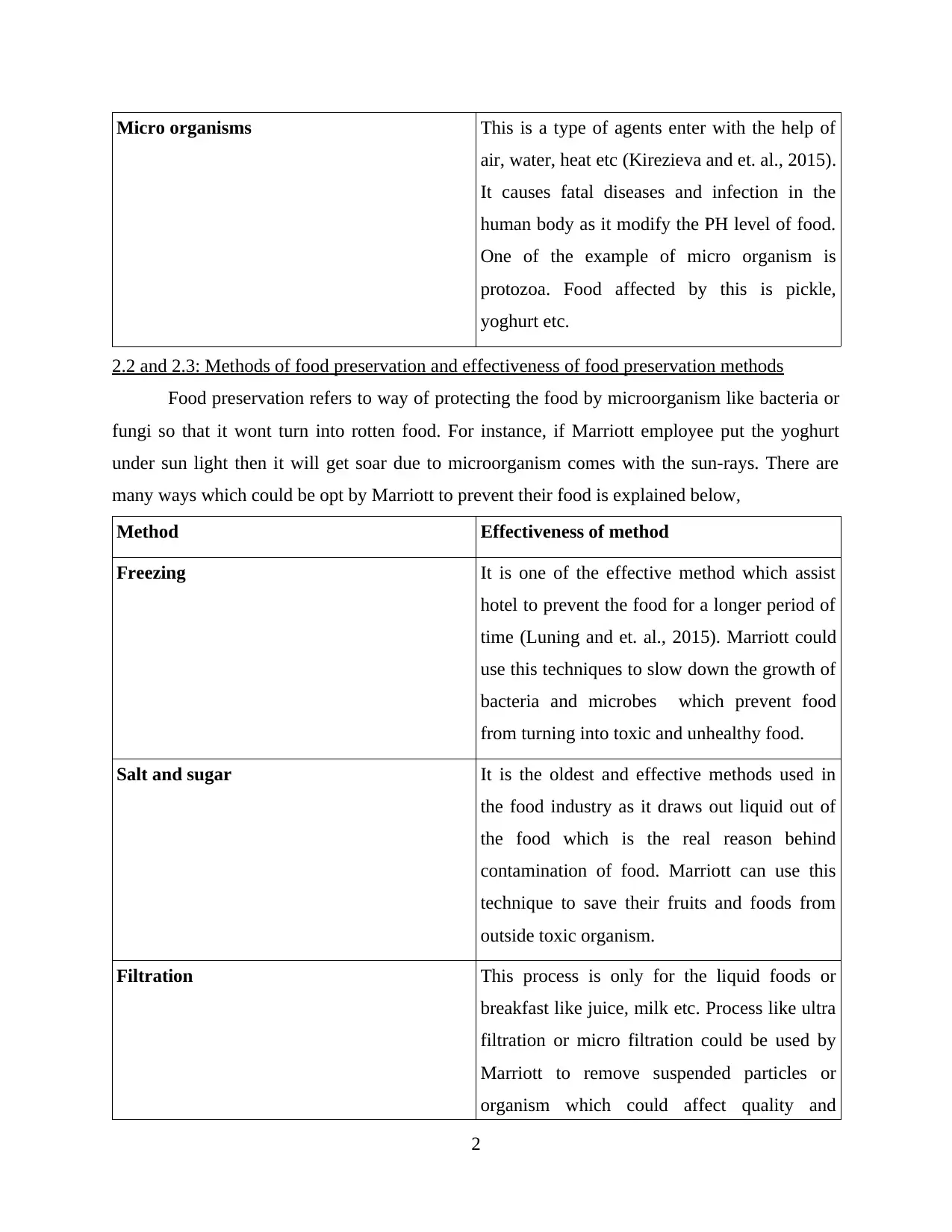
Micro organisms This is a type of agents enter with the help of
air, water, heat etc (Kirezieva and et. al., 2015).
It causes fatal diseases and infection in the
human body as it modify the PH level of food.
One of the example of micro organism is
protozoa. Food affected by this is pickle,
yoghurt etc.
2.2 and 2.3: Methods of food preservation and effectiveness of food preservation methods
Food preservation refers to way of protecting the food by microorganism like bacteria or
fungi so that it wont turn into rotten food. For instance, if Marriott employee put the yoghurt
under sun light then it will get soar due to microorganism comes with the sun-rays. There are
many ways which could be opt by Marriott to prevent their food is explained below,
Method Effectiveness of method
Freezing It is one of the effective method which assist
hotel to prevent the food for a longer period of
time (Luning and et. al., 2015). Marriott could
use this techniques to slow down the growth of
bacteria and microbes which prevent food
from turning into toxic and unhealthy food.
Salt and sugar It is the oldest and effective methods used in
the food industry as it draws out liquid out of
the food which is the real reason behind
contamination of food. Marriott can use this
technique to save their fruits and foods from
outside toxic organism.
Filtration This process is only for the liquid foods or
breakfast like juice, milk etc. Process like ultra
filtration or micro filtration could be used by
Marriott to remove suspended particles or
organism which could affect quality and
2
air, water, heat etc (Kirezieva and et. al., 2015).
It causes fatal diseases and infection in the
human body as it modify the PH level of food.
One of the example of micro organism is
protozoa. Food affected by this is pickle,
yoghurt etc.
2.2 and 2.3: Methods of food preservation and effectiveness of food preservation methods
Food preservation refers to way of protecting the food by microorganism like bacteria or
fungi so that it wont turn into rotten food. For instance, if Marriott employee put the yoghurt
under sun light then it will get soar due to microorganism comes with the sun-rays. There are
many ways which could be opt by Marriott to prevent their food is explained below,
Method Effectiveness of method
Freezing It is one of the effective method which assist
hotel to prevent the food for a longer period of
time (Luning and et. al., 2015). Marriott could
use this techniques to slow down the growth of
bacteria and microbes which prevent food
from turning into toxic and unhealthy food.
Salt and sugar It is the oldest and effective methods used in
the food industry as it draws out liquid out of
the food which is the real reason behind
contamination of food. Marriott can use this
technique to save their fruits and foods from
outside toxic organism.
Filtration This process is only for the liquid foods or
breakfast like juice, milk etc. Process like ultra
filtration or micro filtration could be used by
Marriott to remove suspended particles or
organism which could affect quality and
2
Secure Best Marks with AI Grader
Need help grading? Try our AI Grader for instant feedback on your assignments.
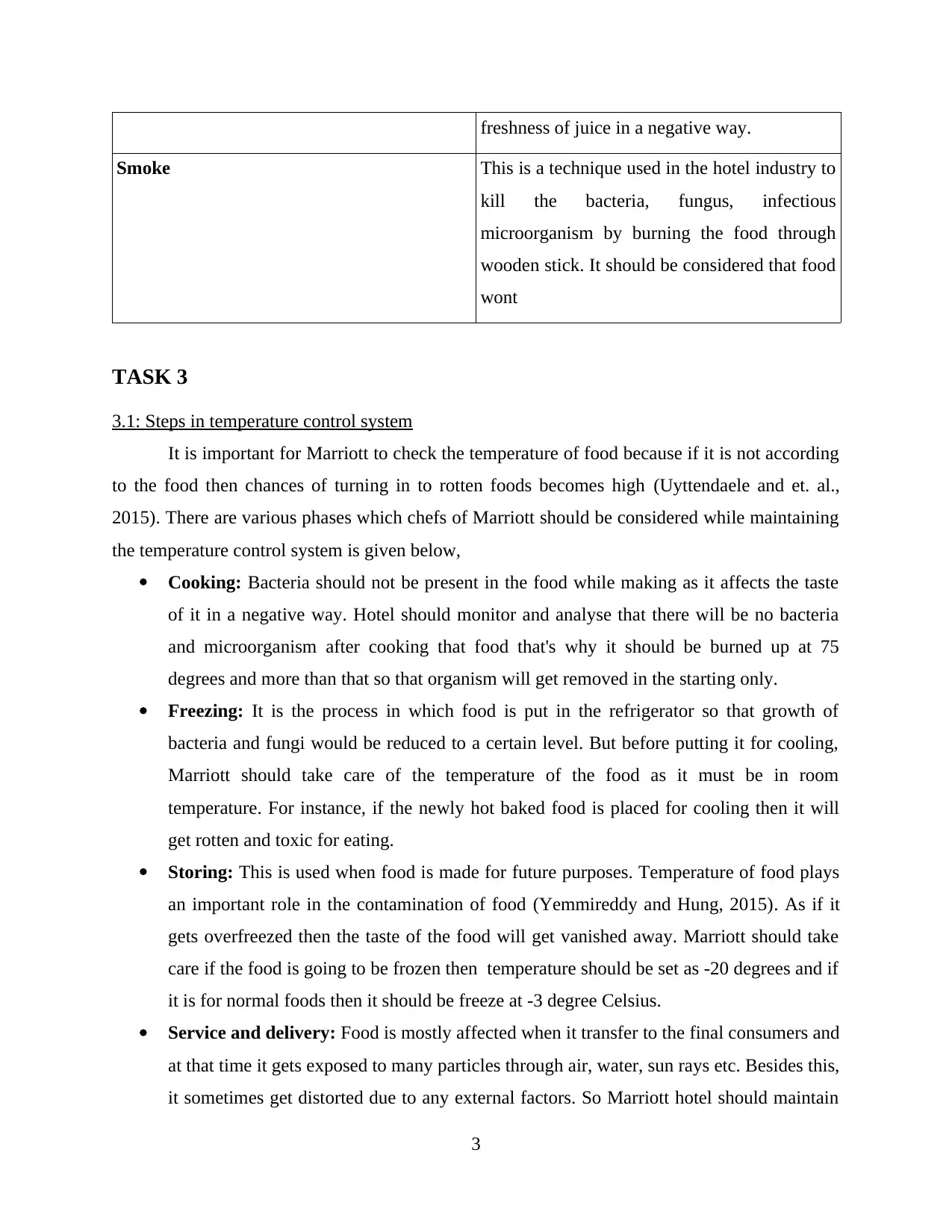
freshness of juice in a negative way.
Smoke This is a technique used in the hotel industry to
kill the bacteria, fungus, infectious
microorganism by burning the food through
wooden stick. It should be considered that food
wont
TASK 3
3.1: Steps in temperature control system
It is important for Marriott to check the temperature of food because if it is not according
to the food then chances of turning in to rotten foods becomes high (Uyttendaele and et. al.,
2015). There are various phases which chefs of Marriott should be considered while maintaining
the temperature control system is given below,
Cooking: Bacteria should not be present in the food while making as it affects the taste
of it in a negative way. Hotel should monitor and analyse that there will be no bacteria
and microorganism after cooking that food that's why it should be burned up at 75
degrees and more than that so that organism will get removed in the starting only.
Freezing: It is the process in which food is put in the refrigerator so that growth of
bacteria and fungi would be reduced to a certain level. But before putting it for cooling,
Marriott should take care of the temperature of the food as it must be in room
temperature. For instance, if the newly hot baked food is placed for cooling then it will
get rotten and toxic for eating.
Storing: This is used when food is made for future purposes. Temperature of food plays
an important role in the contamination of food (Yemmireddy and Hung, 2015). As if it
gets overfreezed then the taste of the food will get vanished away. Marriott should take
care if the food is going to be frozen then temperature should be set as -20 degrees and if
it is for normal foods then it should be freeze at -3 degree Celsius.
Service and delivery: Food is mostly affected when it transfer to the final consumers and
at that time it gets exposed to many particles through air, water, sun rays etc. Besides this,
it sometimes get distorted due to any external factors. So Marriott hotel should maintain
3
Smoke This is a technique used in the hotel industry to
kill the bacteria, fungus, infectious
microorganism by burning the food through
wooden stick. It should be considered that food
wont
TASK 3
3.1: Steps in temperature control system
It is important for Marriott to check the temperature of food because if it is not according
to the food then chances of turning in to rotten foods becomes high (Uyttendaele and et. al.,
2015). There are various phases which chefs of Marriott should be considered while maintaining
the temperature control system is given below,
Cooking: Bacteria should not be present in the food while making as it affects the taste
of it in a negative way. Hotel should monitor and analyse that there will be no bacteria
and microorganism after cooking that food that's why it should be burned up at 75
degrees and more than that so that organism will get removed in the starting only.
Freezing: It is the process in which food is put in the refrigerator so that growth of
bacteria and fungi would be reduced to a certain level. But before putting it for cooling,
Marriott should take care of the temperature of the food as it must be in room
temperature. For instance, if the newly hot baked food is placed for cooling then it will
get rotten and toxic for eating.
Storing: This is used when food is made for future purposes. Temperature of food plays
an important role in the contamination of food (Yemmireddy and Hung, 2015). As if it
gets overfreezed then the taste of the food will get vanished away. Marriott should take
care if the food is going to be frozen then temperature should be set as -20 degrees and if
it is for normal foods then it should be freeze at -3 degree Celsius.
Service and delivery: Food is mostly affected when it transfer to the final consumers and
at that time it gets exposed to many particles through air, water, sun rays etc. Besides this,
it sometimes get distorted due to any external factors. So Marriott hotel should maintain
3
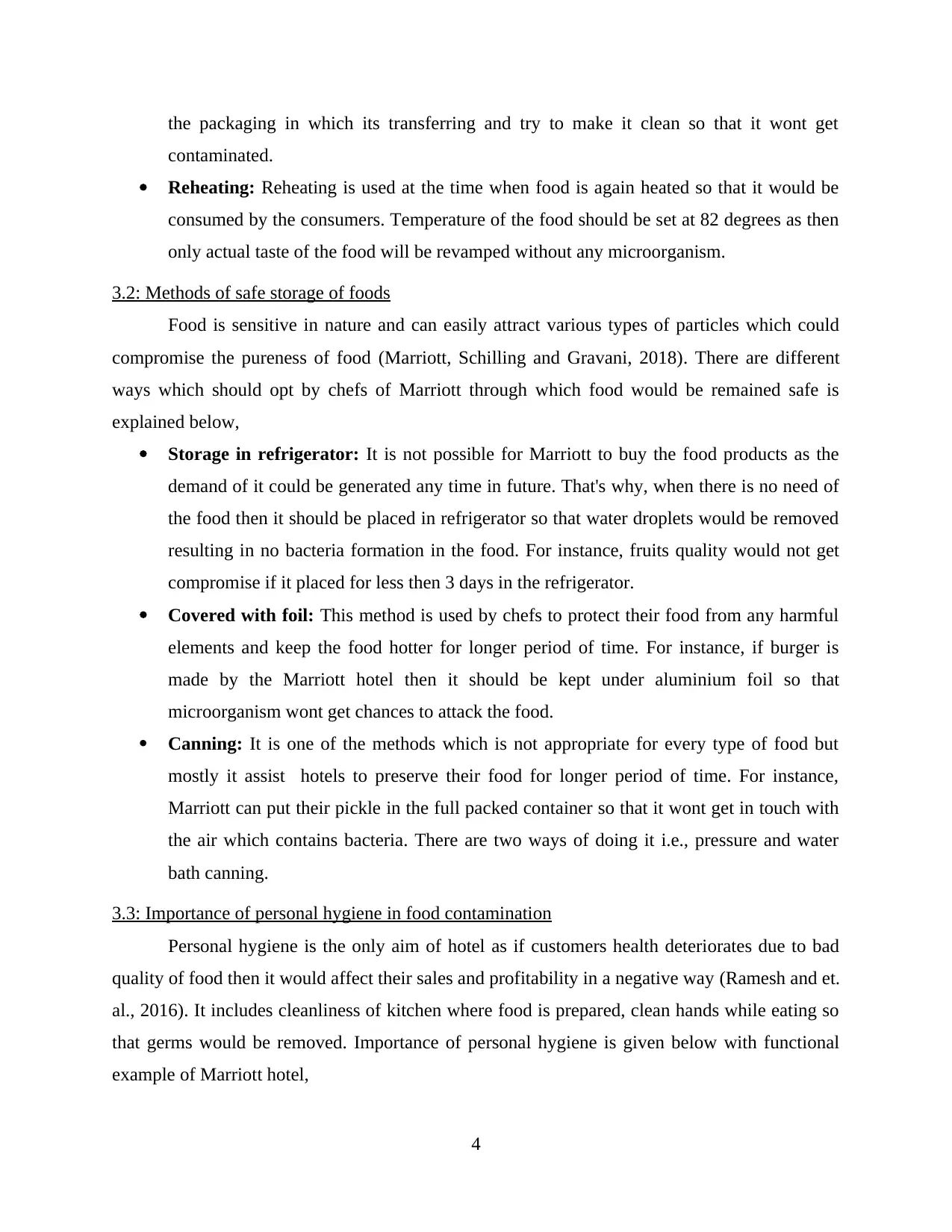
the packaging in which its transferring and try to make it clean so that it wont get
contaminated.
Reheating: Reheating is used at the time when food is again heated so that it would be
consumed by the consumers. Temperature of the food should be set at 82 degrees as then
only actual taste of the food will be revamped without any microorganism.
3.2: Methods of safe storage of foods
Food is sensitive in nature and can easily attract various types of particles which could
compromise the pureness of food (Marriott, Schilling and Gravani, 2018). There are different
ways which should opt by chefs of Marriott through which food would be remained safe is
explained below,
Storage in refrigerator: It is not possible for Marriott to buy the food products as the
demand of it could be generated any time in future. That's why, when there is no need of
the food then it should be placed in refrigerator so that water droplets would be removed
resulting in no bacteria formation in the food. For instance, fruits quality would not get
compromise if it placed for less then 3 days in the refrigerator.
Covered with foil: This method is used by chefs to protect their food from any harmful
elements and keep the food hotter for longer period of time. For instance, if burger is
made by the Marriott hotel then it should be kept under aluminium foil so that
microorganism wont get chances to attack the food.
Canning: It is one of the methods which is not appropriate for every type of food but
mostly it assist hotels to preserve their food for longer period of time. For instance,
Marriott can put their pickle in the full packed container so that it wont get in touch with
the air which contains bacteria. There are two ways of doing it i.e., pressure and water
bath canning.
3.3: Importance of personal hygiene in food contamination
Personal hygiene is the only aim of hotel as if customers health deteriorates due to bad
quality of food then it would affect their sales and profitability in a negative way (Ramesh and et.
al., 2016). It includes cleanliness of kitchen where food is prepared, clean hands while eating so
that germs would be removed. Importance of personal hygiene is given below with functional
example of Marriott hotel,
4
contaminated.
Reheating: Reheating is used at the time when food is again heated so that it would be
consumed by the consumers. Temperature of the food should be set at 82 degrees as then
only actual taste of the food will be revamped without any microorganism.
3.2: Methods of safe storage of foods
Food is sensitive in nature and can easily attract various types of particles which could
compromise the pureness of food (Marriott, Schilling and Gravani, 2018). There are different
ways which should opt by chefs of Marriott through which food would be remained safe is
explained below,
Storage in refrigerator: It is not possible for Marriott to buy the food products as the
demand of it could be generated any time in future. That's why, when there is no need of
the food then it should be placed in refrigerator so that water droplets would be removed
resulting in no bacteria formation in the food. For instance, fruits quality would not get
compromise if it placed for less then 3 days in the refrigerator.
Covered with foil: This method is used by chefs to protect their food from any harmful
elements and keep the food hotter for longer period of time. For instance, if burger is
made by the Marriott hotel then it should be kept under aluminium foil so that
microorganism wont get chances to attack the food.
Canning: It is one of the methods which is not appropriate for every type of food but
mostly it assist hotels to preserve their food for longer period of time. For instance,
Marriott can put their pickle in the full packed container so that it wont get in touch with
the air which contains bacteria. There are two ways of doing it i.e., pressure and water
bath canning.
3.3: Importance of personal hygiene in food contamination
Personal hygiene is the only aim of hotel as if customers health deteriorates due to bad
quality of food then it would affect their sales and profitability in a negative way (Ramesh and et.
al., 2016). It includes cleanliness of kitchen where food is prepared, clean hands while eating so
that germs would be removed. Importance of personal hygiene is given below with functional
example of Marriott hotel,
4
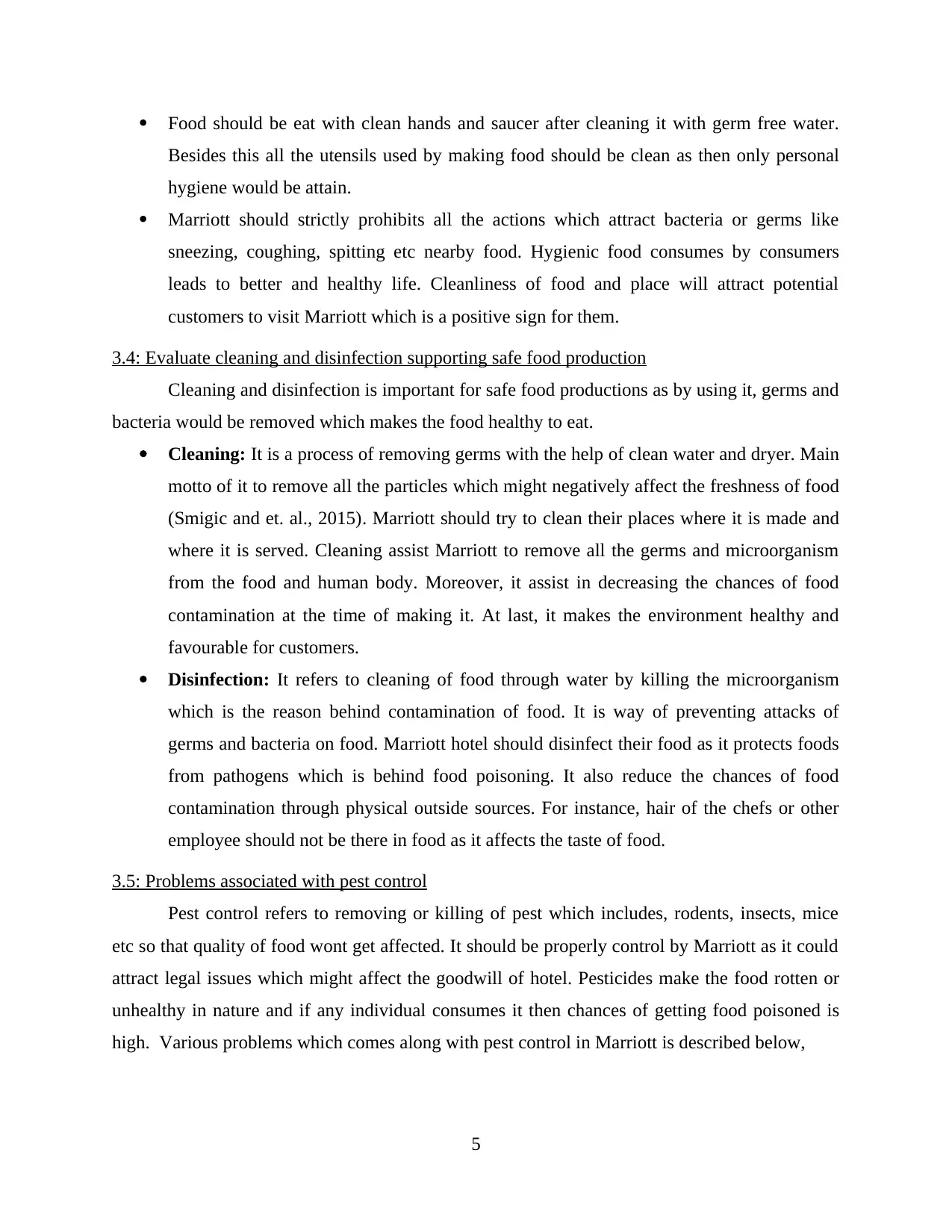
Food should be eat with clean hands and saucer after cleaning it with germ free water.
Besides this all the utensils used by making food should be clean as then only personal
hygiene would be attain.
Marriott should strictly prohibits all the actions which attract bacteria or germs like
sneezing, coughing, spitting etc nearby food. Hygienic food consumes by consumers
leads to better and healthy life. Cleanliness of food and place will attract potential
customers to visit Marriott which is a positive sign for them.
3.4: Evaluate cleaning and disinfection supporting safe food production
Cleaning and disinfection is important for safe food productions as by using it, germs and
bacteria would be removed which makes the food healthy to eat.
Cleaning: It is a process of removing germs with the help of clean water and dryer. Main
motto of it to remove all the particles which might negatively affect the freshness of food
(Smigic and et. al., 2015). Marriott should try to clean their places where it is made and
where it is served. Cleaning assist Marriott to remove all the germs and microorganism
from the food and human body. Moreover, it assist in decreasing the chances of food
contamination at the time of making it. At last, it makes the environment healthy and
favourable for customers.
Disinfection: It refers to cleaning of food through water by killing the microorganism
which is the reason behind contamination of food. It is way of preventing attacks of
germs and bacteria on food. Marriott hotel should disinfect their food as it protects foods
from pathogens which is behind food poisoning. It also reduce the chances of food
contamination through physical outside sources. For instance, hair of the chefs or other
employee should not be there in food as it affects the taste of food.
3.5: Problems associated with pest control
Pest control refers to removing or killing of pest which includes, rodents, insects, mice
etc so that quality of food wont get affected. It should be properly control by Marriott as it could
attract legal issues which might affect the goodwill of hotel. Pesticides make the food rotten or
unhealthy in nature and if any individual consumes it then chances of getting food poisoned is
high. Various problems which comes along with pest control in Marriott is described below,
5
Besides this all the utensils used by making food should be clean as then only personal
hygiene would be attain.
Marriott should strictly prohibits all the actions which attract bacteria or germs like
sneezing, coughing, spitting etc nearby food. Hygienic food consumes by consumers
leads to better and healthy life. Cleanliness of food and place will attract potential
customers to visit Marriott which is a positive sign for them.
3.4: Evaluate cleaning and disinfection supporting safe food production
Cleaning and disinfection is important for safe food productions as by using it, germs and
bacteria would be removed which makes the food healthy to eat.
Cleaning: It is a process of removing germs with the help of clean water and dryer. Main
motto of it to remove all the particles which might negatively affect the freshness of food
(Smigic and et. al., 2015). Marriott should try to clean their places where it is made and
where it is served. Cleaning assist Marriott to remove all the germs and microorganism
from the food and human body. Moreover, it assist in decreasing the chances of food
contamination at the time of making it. At last, it makes the environment healthy and
favourable for customers.
Disinfection: It refers to cleaning of food through water by killing the microorganism
which is the reason behind contamination of food. It is way of preventing attacks of
germs and bacteria on food. Marriott hotel should disinfect their food as it protects foods
from pathogens which is behind food poisoning. It also reduce the chances of food
contamination through physical outside sources. For instance, hair of the chefs or other
employee should not be there in food as it affects the taste of food.
3.5: Problems associated with pest control
Pest control refers to removing or killing of pest which includes, rodents, insects, mice
etc so that quality of food wont get affected. It should be properly control by Marriott as it could
attract legal issues which might affect the goodwill of hotel. Pesticides make the food rotten or
unhealthy in nature and if any individual consumes it then chances of getting food poisoned is
high. Various problems which comes along with pest control in Marriott is described below,
5
Paraphrase This Document
Need a fresh take? Get an instant paraphrase of this document with our AI Paraphraser
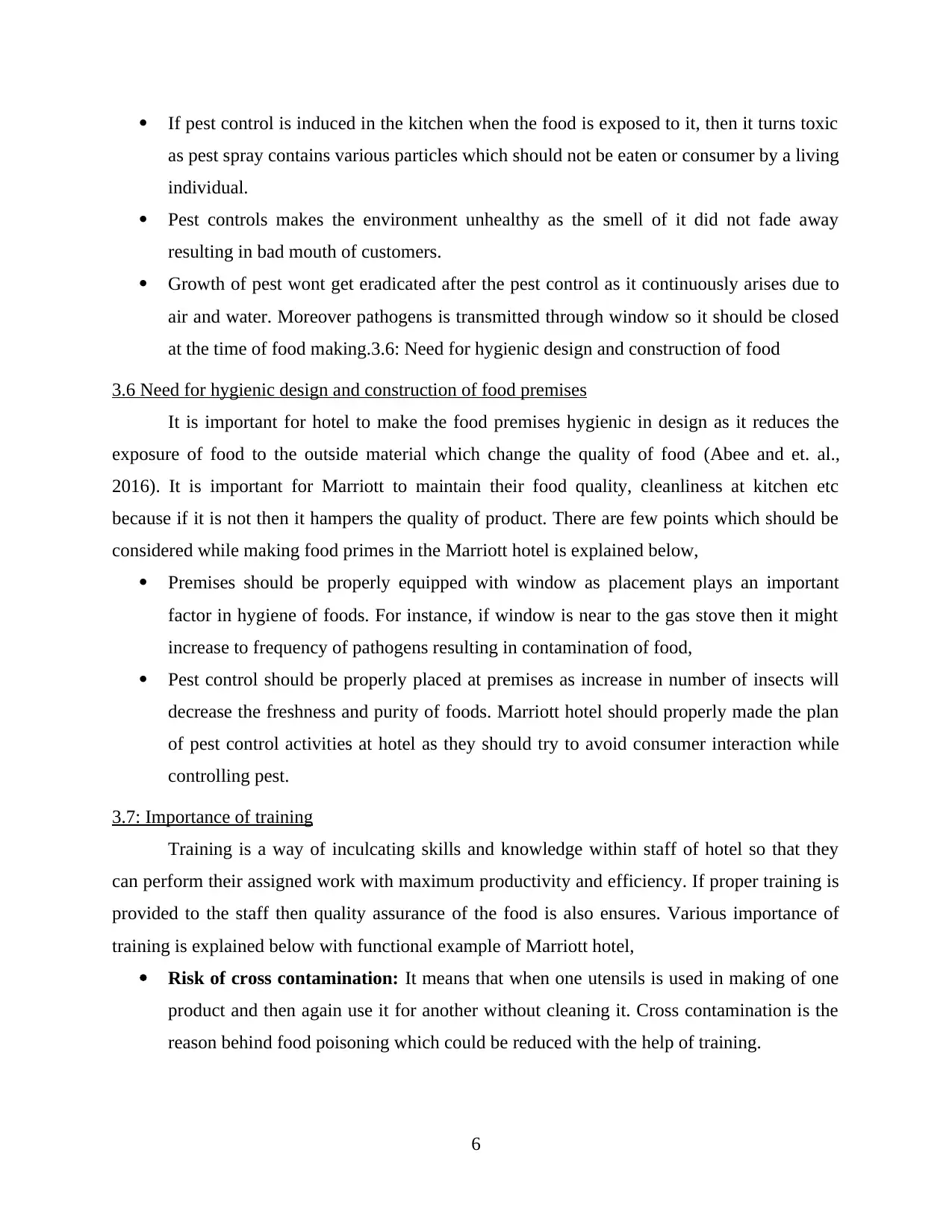
If pest control is induced in the kitchen when the food is exposed to it, then it turns toxic
as pest spray contains various particles which should not be eaten or consumer by a living
individual.
Pest controls makes the environment unhealthy as the smell of it did not fade away
resulting in bad mouth of customers.
Growth of pest wont get eradicated after the pest control as it continuously arises due to
air and water. Moreover pathogens is transmitted through window so it should be closed
at the time of food making.3.6: Need for hygienic design and construction of food
3.6 Need for hygienic design and construction of food premises
It is important for hotel to make the food premises hygienic in design as it reduces the
exposure of food to the outside material which change the quality of food (Abee and et. al.,
2016). It is important for Marriott to maintain their food quality, cleanliness at kitchen etc
because if it is not then it hampers the quality of product. There are few points which should be
considered while making food primes in the Marriott hotel is explained below,
Premises should be properly equipped with window as placement plays an important
factor in hygiene of foods. For instance, if window is near to the gas stove then it might
increase to frequency of pathogens resulting in contamination of food,
Pest control should be properly placed at premises as increase in number of insects will
decrease the freshness and purity of foods. Marriott hotel should properly made the plan
of pest control activities at hotel as they should try to avoid consumer interaction while
controlling pest.
3.7: Importance of training
Training is a way of inculcating skills and knowledge within staff of hotel so that they
can perform their assigned work with maximum productivity and efficiency. If proper training is
provided to the staff then quality assurance of the food is also ensures. Various importance of
training is explained below with functional example of Marriott hotel,
Risk of cross contamination: It means that when one utensils is used in making of one
product and then again use it for another without cleaning it. Cross contamination is the
reason behind food poisoning which could be reduced with the help of training.
6
as pest spray contains various particles which should not be eaten or consumer by a living
individual.
Pest controls makes the environment unhealthy as the smell of it did not fade away
resulting in bad mouth of customers.
Growth of pest wont get eradicated after the pest control as it continuously arises due to
air and water. Moreover pathogens is transmitted through window so it should be closed
at the time of food making.3.6: Need for hygienic design and construction of food
3.6 Need for hygienic design and construction of food premises
It is important for hotel to make the food premises hygienic in design as it reduces the
exposure of food to the outside material which change the quality of food (Abee and et. al.,
2016). It is important for Marriott to maintain their food quality, cleanliness at kitchen etc
because if it is not then it hampers the quality of product. There are few points which should be
considered while making food primes in the Marriott hotel is explained below,
Premises should be properly equipped with window as placement plays an important
factor in hygiene of foods. For instance, if window is near to the gas stove then it might
increase to frequency of pathogens resulting in contamination of food,
Pest control should be properly placed at premises as increase in number of insects will
decrease the freshness and purity of foods. Marriott hotel should properly made the plan
of pest control activities at hotel as they should try to avoid consumer interaction while
controlling pest.
3.7: Importance of training
Training is a way of inculcating skills and knowledge within staff of hotel so that they
can perform their assigned work with maximum productivity and efficiency. If proper training is
provided to the staff then quality assurance of the food is also ensures. Various importance of
training is explained below with functional example of Marriott hotel,
Risk of cross contamination: It means that when one utensils is used in making of one
product and then again use it for another without cleaning it. Cross contamination is the
reason behind food poisoning which could be reduced with the help of training.
6
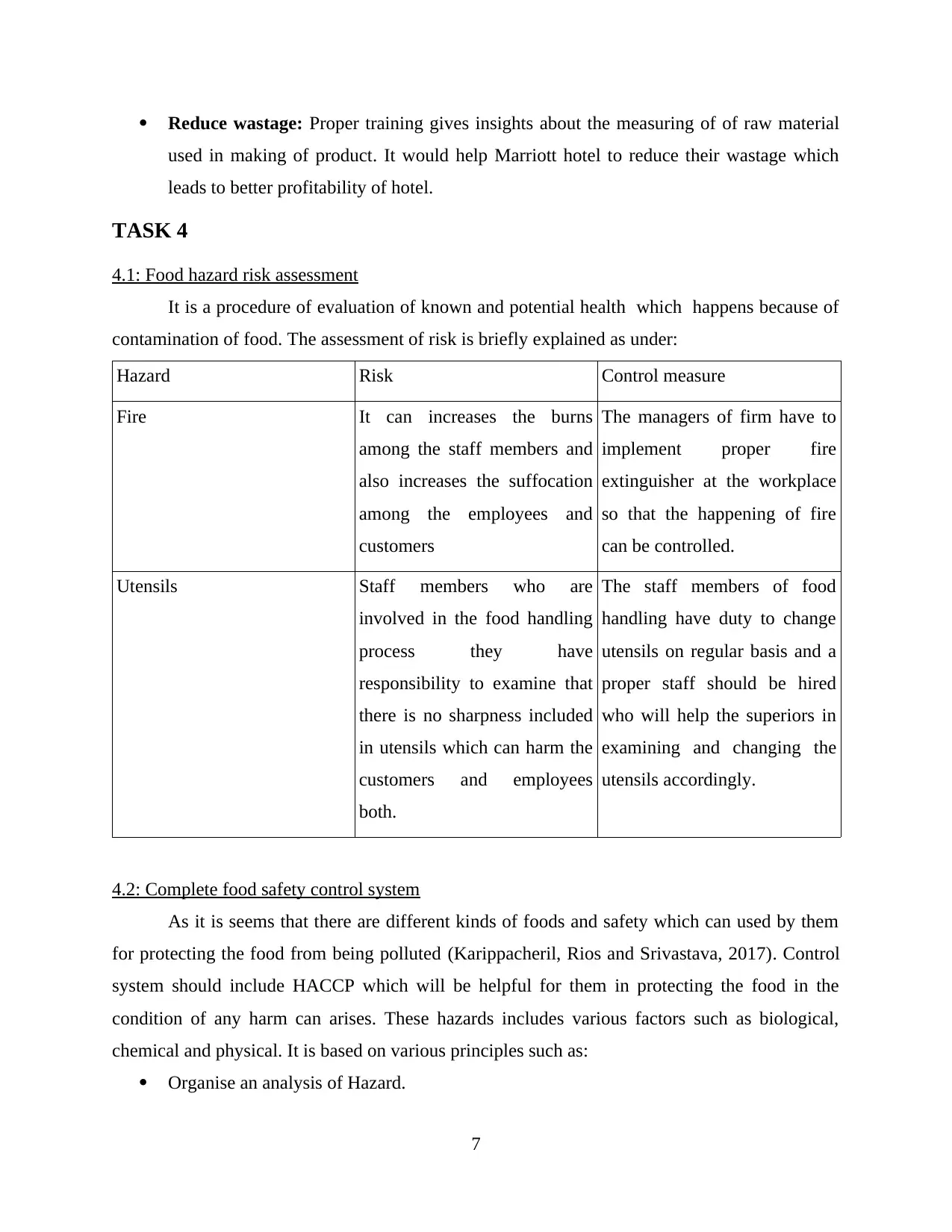
Reduce wastage: Proper training gives insights about the measuring of of raw material
used in making of product. It would help Marriott hotel to reduce their wastage which
leads to better profitability of hotel.
TASK 4
4.1: Food hazard risk assessment
It is a procedure of evaluation of known and potential health which happens because of
contamination of food. The assessment of risk is briefly explained as under:
Hazard Risk Control measure
Fire It can increases the burns
among the staff members and
also increases the suffocation
among the employees and
customers
The managers of firm have to
implement proper fire
extinguisher at the workplace
so that the happening of fire
can be controlled.
Utensils Staff members who are
involved in the food handling
process they have
responsibility to examine that
there is no sharpness included
in utensils which can harm the
customers and employees
both.
The staff members of food
handling have duty to change
utensils on regular basis and a
proper staff should be hired
who will help the superiors in
examining and changing the
utensils accordingly.
4.2: Complete food safety control system
As it is seems that there are different kinds of foods and safety which can used by them
for protecting the food from being polluted (Karippacheril, Rios and Srivastava, 2017). Control
system should include HACCP which will be helpful for them in protecting the food in the
condition of any harm can arises. These hazards includes various factors such as biological,
chemical and physical. It is based on various principles such as:
Organise an analysis of Hazard.
7
used in making of product. It would help Marriott hotel to reduce their wastage which
leads to better profitability of hotel.
TASK 4
4.1: Food hazard risk assessment
It is a procedure of evaluation of known and potential health which happens because of
contamination of food. The assessment of risk is briefly explained as under:
Hazard Risk Control measure
Fire It can increases the burns
among the staff members and
also increases the suffocation
among the employees and
customers
The managers of firm have to
implement proper fire
extinguisher at the workplace
so that the happening of fire
can be controlled.
Utensils Staff members who are
involved in the food handling
process they have
responsibility to examine that
there is no sharpness included
in utensils which can harm the
customers and employees
both.
The staff members of food
handling have duty to change
utensils on regular basis and a
proper staff should be hired
who will help the superiors in
examining and changing the
utensils accordingly.
4.2: Complete food safety control system
As it is seems that there are different kinds of foods and safety which can used by them
for protecting the food from being polluted (Karippacheril, Rios and Srivastava, 2017). Control
system should include HACCP which will be helpful for them in protecting the food in the
condition of any harm can arises. These hazards includes various factors such as biological,
chemical and physical. It is based on various principles such as:
Organise an analysis of Hazard.
7
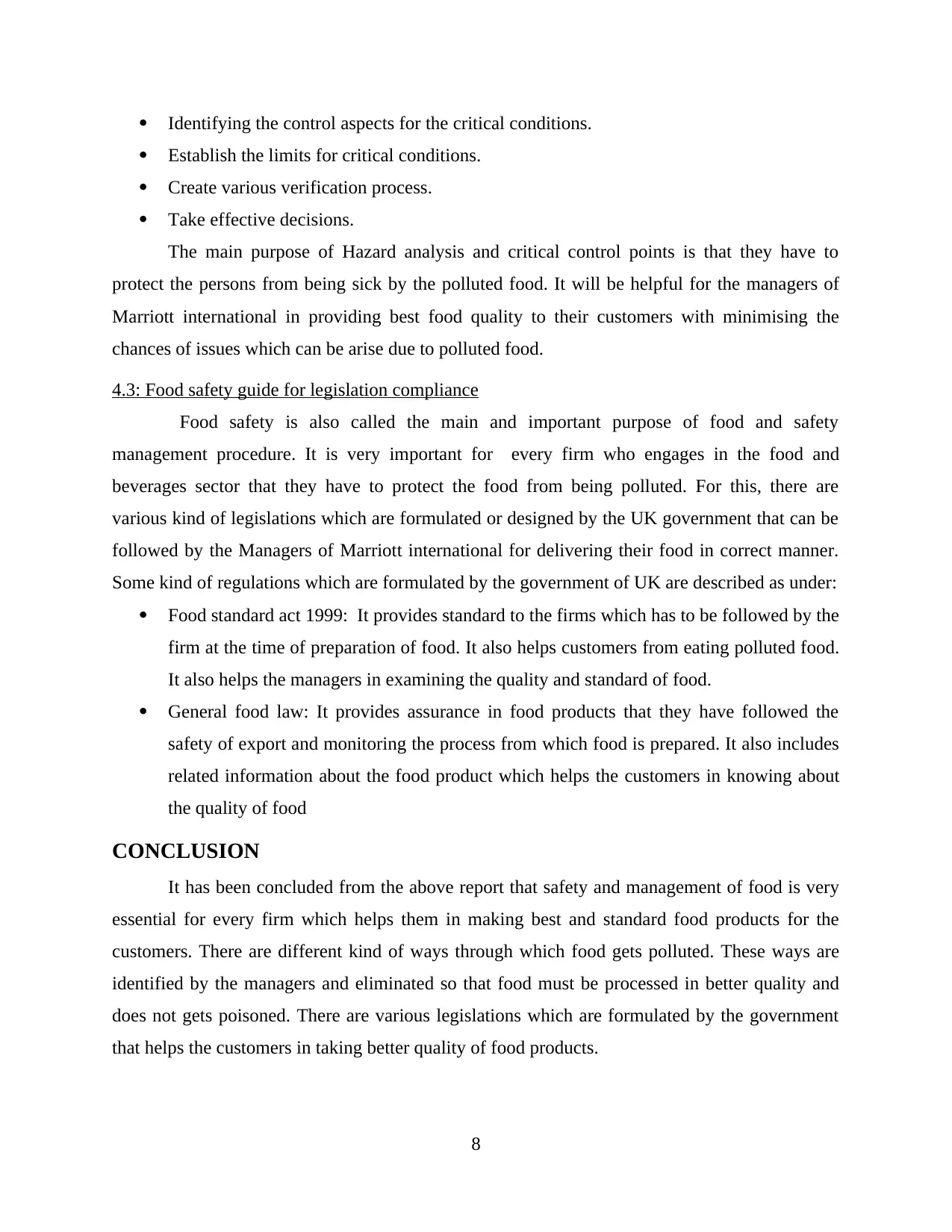
Identifying the control aspects for the critical conditions.
Establish the limits for critical conditions.
Create various verification process.
Take effective decisions.
The main purpose of Hazard analysis and critical control points is that they have to
protect the persons from being sick by the polluted food. It will be helpful for the managers of
Marriott international in providing best food quality to their customers with minimising the
chances of issues which can be arise due to polluted food.
4.3: Food safety guide for legislation compliance
Food safety is also called the main and important purpose of food and safety
management procedure. It is very important for every firm who engages in the food and
beverages sector that they have to protect the food from being polluted. For this, there are
various kind of legislations which are formulated or designed by the UK government that can be
followed by the Managers of Marriott international for delivering their food in correct manner.
Some kind of regulations which are formulated by the government of UK are described as under:
Food standard act 1999: It provides standard to the firms which has to be followed by the
firm at the time of preparation of food. It also helps customers from eating polluted food.
It also helps the managers in examining the quality and standard of food.
General food law: It provides assurance in food products that they have followed the
safety of export and monitoring the process from which food is prepared. It also includes
related information about the food product which helps the customers in knowing about
the quality of food
CONCLUSION
It has been concluded from the above report that safety and management of food is very
essential for every firm which helps them in making best and standard food products for the
customers. There are different kind of ways through which food gets polluted. These ways are
identified by the managers and eliminated so that food must be processed in better quality and
does not gets poisoned. There are various legislations which are formulated by the government
that helps the customers in taking better quality of food products.
8
Establish the limits for critical conditions.
Create various verification process.
Take effective decisions.
The main purpose of Hazard analysis and critical control points is that they have to
protect the persons from being sick by the polluted food. It will be helpful for the managers of
Marriott international in providing best food quality to their customers with minimising the
chances of issues which can be arise due to polluted food.
4.3: Food safety guide for legislation compliance
Food safety is also called the main and important purpose of food and safety
management procedure. It is very important for every firm who engages in the food and
beverages sector that they have to protect the food from being polluted. For this, there are
various kind of legislations which are formulated or designed by the UK government that can be
followed by the Managers of Marriott international for delivering their food in correct manner.
Some kind of regulations which are formulated by the government of UK are described as under:
Food standard act 1999: It provides standard to the firms which has to be followed by the
firm at the time of preparation of food. It also helps customers from eating polluted food.
It also helps the managers in examining the quality and standard of food.
General food law: It provides assurance in food products that they have followed the
safety of export and monitoring the process from which food is prepared. It also includes
related information about the food product which helps the customers in knowing about
the quality of food
CONCLUSION
It has been concluded from the above report that safety and management of food is very
essential for every firm which helps them in making best and standard food products for the
customers. There are different kind of ways through which food gets polluted. These ways are
identified by the managers and eliminated so that food must be processed in better quality and
does not gets poisoned. There are various legislations which are formulated by the government
that helps the customers in taking better quality of food products.
8
Secure Best Marks with AI Grader
Need help grading? Try our AI Grader for instant feedback on your assignments.
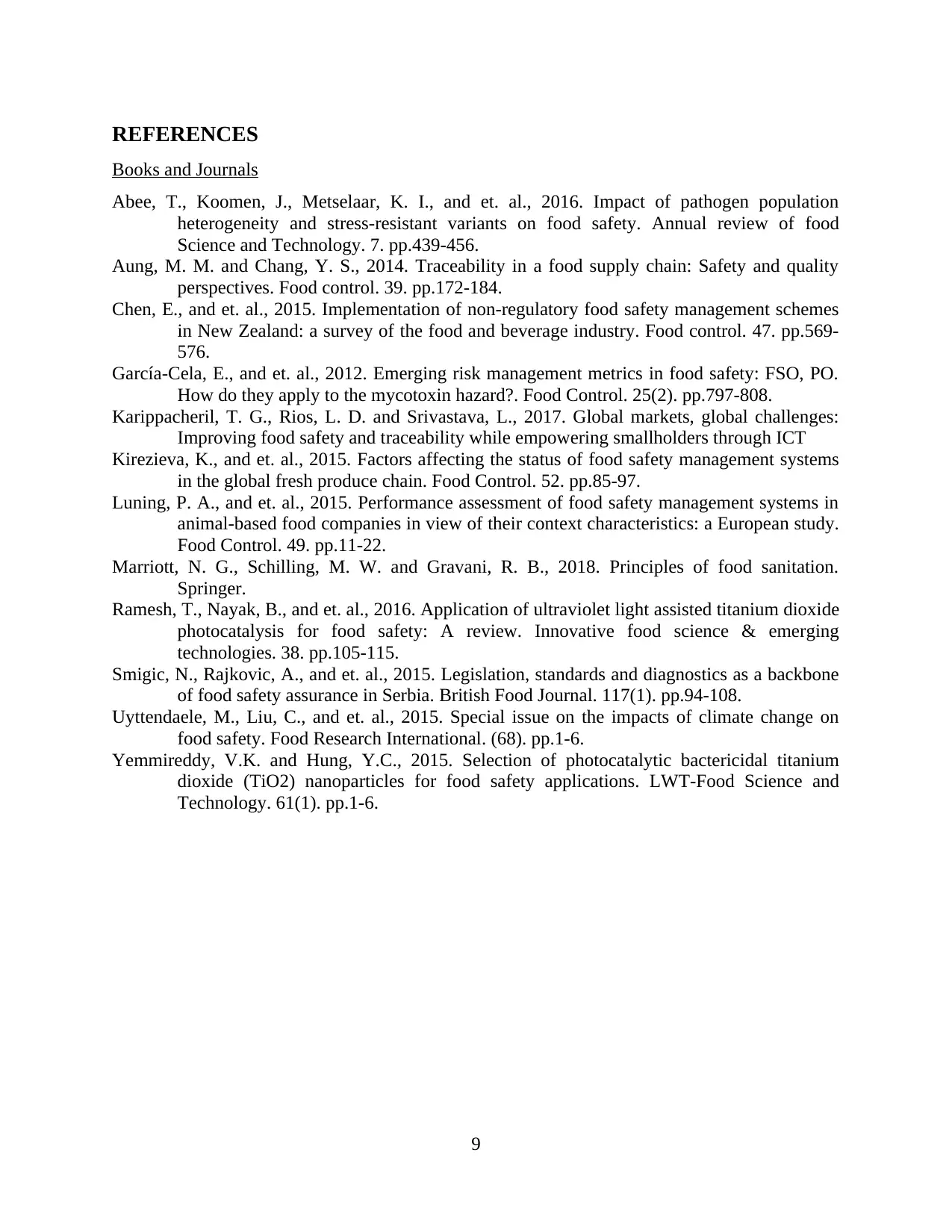
REFERENCES
Books and Journals
Abee, T., Koomen, J., Metselaar, K. I., and et. al., 2016. Impact of pathogen population
heterogeneity and stress-resistant variants on food safety. Annual review of food
Science and Technology. 7. pp.439-456.
Aung, M. M. and Chang, Y. S., 2014. Traceability in a food supply chain: Safety and quality
perspectives. Food control. 39. pp.172-184.
Chen, E., and et. al., 2015. Implementation of non-regulatory food safety management schemes
in New Zealand: a survey of the food and beverage industry. Food control. 47. pp.569-
576.
García-Cela, E., and et. al., 2012. Emerging risk management metrics in food safety: FSO, PO.
How do they apply to the mycotoxin hazard?. Food Control. 25(2). pp.797-808.
Karippacheril, T. G., Rios, L. D. and Srivastava, L., 2017. Global markets, global challenges:
Improving food safety and traceability while empowering smallholders through ICT
Kirezieva, K., and et. al., 2015. Factors affecting the status of food safety management systems
in the global fresh produce chain. Food Control. 52. pp.85-97.
Luning, P. A., and et. al., 2015. Performance assessment of food safety management systems in
animal-based food companies in view of their context characteristics: a European study.
Food Control. 49. pp.11-22.
Marriott, N. G., Schilling, M. W. and Gravani, R. B., 2018. Principles of food sanitation.
Springer.
Ramesh, T., Nayak, B., and et. al., 2016. Application of ultraviolet light assisted titanium dioxide
photocatalysis for food safety: A review. Innovative food science & emerging
technologies. 38. pp.105-115.
Smigic, N., Rajkovic, A., and et. al., 2015. Legislation, standards and diagnostics as a backbone
of food safety assurance in Serbia. British Food Journal. 117(1). pp.94-108.
Uyttendaele, M., Liu, C., and et. al., 2015. Special issue on the impacts of climate change on
food safety. Food Research International. (68). pp.1-6.
Yemmireddy, V.K. and Hung, Y.C., 2015. Selection of photocatalytic bactericidal titanium
dioxide (TiO2) nanoparticles for food safety applications. LWT-Food Science and
Technology. 61(1). pp.1-6.
9
Books and Journals
Abee, T., Koomen, J., Metselaar, K. I., and et. al., 2016. Impact of pathogen population
heterogeneity and stress-resistant variants on food safety. Annual review of food
Science and Technology. 7. pp.439-456.
Aung, M. M. and Chang, Y. S., 2014. Traceability in a food supply chain: Safety and quality
perspectives. Food control. 39. pp.172-184.
Chen, E., and et. al., 2015. Implementation of non-regulatory food safety management schemes
in New Zealand: a survey of the food and beverage industry. Food control. 47. pp.569-
576.
García-Cela, E., and et. al., 2012. Emerging risk management metrics in food safety: FSO, PO.
How do they apply to the mycotoxin hazard?. Food Control. 25(2). pp.797-808.
Karippacheril, T. G., Rios, L. D. and Srivastava, L., 2017. Global markets, global challenges:
Improving food safety and traceability while empowering smallholders through ICT
Kirezieva, K., and et. al., 2015. Factors affecting the status of food safety management systems
in the global fresh produce chain. Food Control. 52. pp.85-97.
Luning, P. A., and et. al., 2015. Performance assessment of food safety management systems in
animal-based food companies in view of their context characteristics: a European study.
Food Control. 49. pp.11-22.
Marriott, N. G., Schilling, M. W. and Gravani, R. B., 2018. Principles of food sanitation.
Springer.
Ramesh, T., Nayak, B., and et. al., 2016. Application of ultraviolet light assisted titanium dioxide
photocatalysis for food safety: A review. Innovative food science & emerging
technologies. 38. pp.105-115.
Smigic, N., Rajkovic, A., and et. al., 2015. Legislation, standards and diagnostics as a backbone
of food safety assurance in Serbia. British Food Journal. 117(1). pp.94-108.
Uyttendaele, M., Liu, C., and et. al., 2015. Special issue on the impacts of climate change on
food safety. Food Research International. (68). pp.1-6.
Yemmireddy, V.K. and Hung, Y.C., 2015. Selection of photocatalytic bactericidal titanium
dioxide (TiO2) nanoparticles for food safety applications. LWT-Food Science and
Technology. 61(1). pp.1-6.
9
1 out of 11
Related Documents
Your All-in-One AI-Powered Toolkit for Academic Success.
+13062052269
info@desklib.com
Available 24*7 on WhatsApp / Email
![[object Object]](/_next/static/media/star-bottom.7253800d.svg)
Unlock your academic potential
© 2024 | Zucol Services PVT LTD | All rights reserved.





